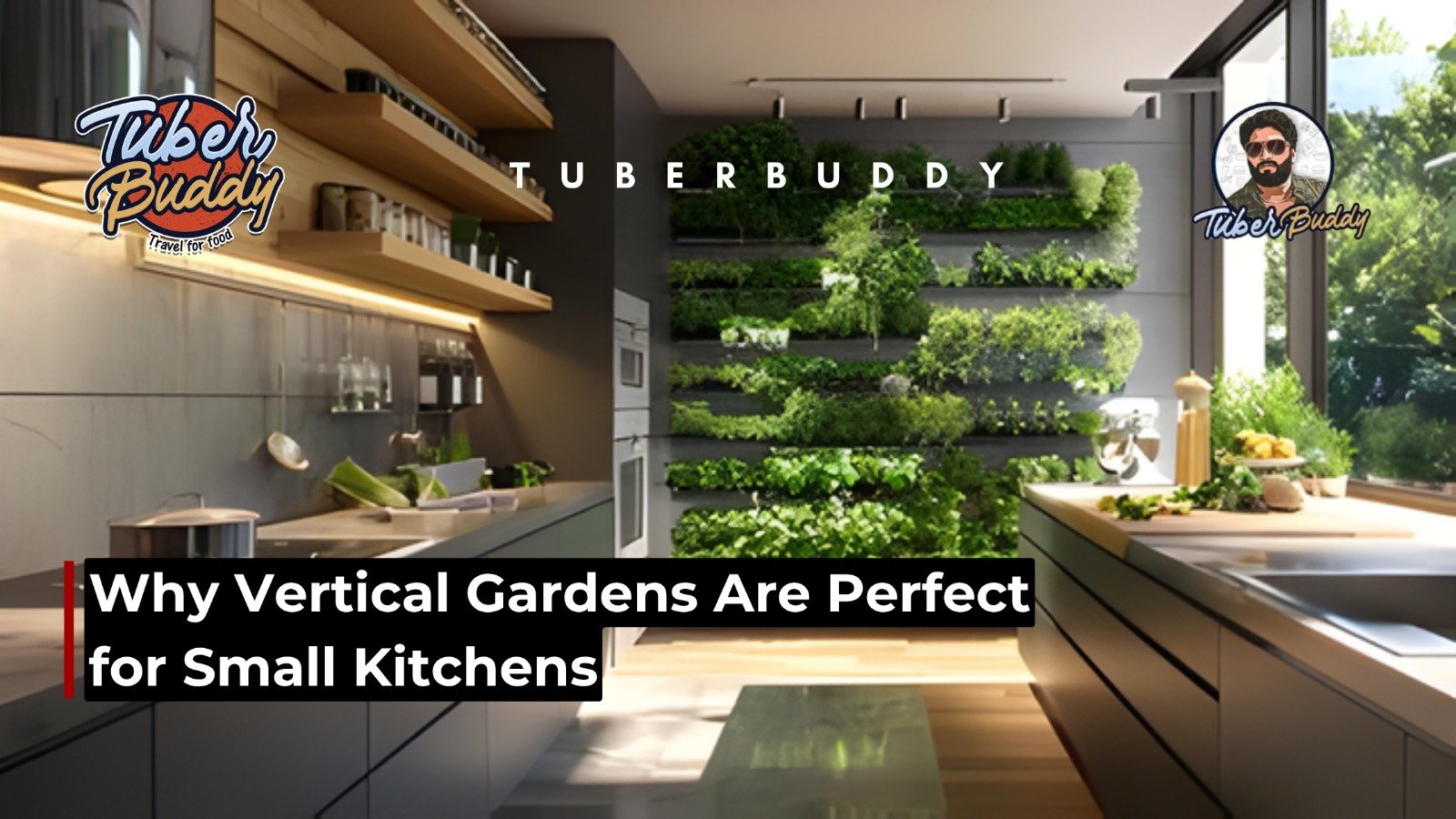
Why Vertical Gardens Are Perfect for Small Kitchens
Introduction: Merging Greenery in Tiny Spaces
If you reside in an apartment or small kitchen, then you know the conundrum of desiring fresh herbs or plants but lacking counter space or floor space to give. The good news: You don’t have to possess a large backyard or balcony room space to perform garden magic. Vertical gardens — living walls or green walls — are giving small kitchens a fresh, bright, and green face.
Vertical gardening refers to the cultivation of crops upwards, on walls, hanging gardens, or on shelves instead of garden beds. It is a space-efficient solution that transforms your kitchen to be healthier, more beautiful, and more practical.
In this blog, let’s discuss why vertical gardens are the best-suited for small kitchens, how to have them installed, and what advantages they provide for your home and life.
1. Space-Saving Magic: Getting the Most Out of Tiny Kitchens
The small kitchen will soon become cluttered, such as the time when you try to stack everything — appliances, tools, and materials — in a single small space. Vertical gardens convert underutilized wall space into a green space.
Rather than using the standard pots that occupy precious countertop space, wall or vertical planters permit you to garden vertically. Regardless of the space is a thin wall, a window ledge, or even the edge of your refrigerator, you can have a small garden in nearly any location.
Tip: Place vertical planters or magnetic planters that can be installed on your refrigerator or cabinet doors. It’s stylish and convenient to introduce life into the kitchen without taking up your space.
2. Fresh Herbs at Your Fingertips
Imagine cooking pasta and just reaching up to the fresh basil or thyme — right on your kitchen wall. That’s the magic of a vertical herb garden.
Herbs such as coriander, basil, mint, parsley, rosemary, and oregano don’t only flavor what you’re cooking, they also perfume your house. And to have them readily available from your very own garden, you’ll never run out of organic pesticide-free greens to throw in.
You can actually grow such herbs very easily indoors in tiny planters or hanging planners on your wall. All the herbs are easy to grow indoors if they are provided with a lot of light and occasional watering.
Tip: Position your vertical garden in a sunny kitchen window with light of at least 4–6 hours per day.
3. Aesthetic Appeal: Decorating Walls as Art
Vertical gardens give you the immediate appearance of freshness and elegance to your kitchen appearances. Rather than empty walls, you now have greens that make the environment feel peaceful and cozy.
Plants inherently have this need to heat up homes and infuse them with life. With the leaves and natural textures, it gives energy to your kitchen appearances — and that makes it look grandiose, new, and space-age.
As it’s already a decorator, you can even make your vertical garden personalized with variegating leaf textures and colors of plants. Like, add herbs amongst the ornamental plants like succulents, pothos, or spider plants for a work of art.
Tip bonus: Add reclaimed wood shelves, hanging planters, or repurposed mason jars to give it a country, green sheen look.
4. Air-purifying and Kills Kitchen Odors
Kitchen spaces will also tend to retain heat, smoke, and smells. Houseplants are natural air purifiers in the sense that they clean poisons and provide fresh oxygen to the air.
There are some plants such as peace lilies, English ivy, pothos, and ferns that are perfect air purifiers and will remove toxins and make your kitchen smell fresh and clean throughout the day.
Incidentally, NASA studies have found that houseplants purify the air of toxic chemicals like benzene and formaldehyde. So not only do they set your room up to look like it should, but having a few of them in your indoor garden also makes your room feel nice and breezy.
5. Enhances Mental Well-being and Stress Reduction
Cooking. It’s calming — and gardening is. Both, together, such a wonderful way to de-stress after work.
Scientific studies showed us that the presence of plants can not only soothe stress and brighten mood, but even spark creativity. Even the simple act of watering or pruning leaves while maintaining your indoor vertical garden may bring about relaxation and satisfaction.
So whenever you are making breakfast or beginning to cook with a coffee, your plants welcome you in the morning with calmness and freshness. It feels like you are having a little paradise in nature within your home itself.
6. Eco-Friendly and Sustainable Option
Vertical gardens are not just stylish — they’re eco-friendly and sustainable, too. Home-grown fresh greens and herbs cut out plastic-packaged greens use and your carbon footprint.
You can also recycle wooden pallets, jars, or bottles as pots to prevent wastage in the household. And the plants help in the greenery by absorbing carbon dioxide and producing oxygen.
Tip: Utilize organics. Utilize kitchen scraps or compost as organic compost to create a self-sustaining mini ecosystem in the kitchen.
7. Low Maintenance and Personalization
One of the best things about vertical gardens is that they’re low-maintenance. With proper lighting and watering, most plants will thrive indoors with minimal attention.
You can choose automatic watering systems or self-watering planters if you’re busy. Many indoor plants also need minimal sunlight, making them perfect for small kitchens with limited windows.
Customization is also a bonus — need an entire green wall or draping over a number of pots, you can size your vertical garden to suit your life and space. You can begin small with a mini one and grow greater as you discover your own green thumb.
8. Ideal for Apartment Residents and Urban Living
Within the city, as outdoors and balcony are a no-go, vertical gardens make you close to nature once again. They convert kitchen spaces in apartments into customized spaces and make you closer to nature even in the city.
Since you are renting a house, you can indulge in the flexibility of portable or module-based vertical gardens that can be easily transferred from location to location or even dismounted when there is house shifting.
This makes vertical gardening the perfect solution for anybody — working young professional, stay-at-home housewife, or student — who would adore the green way of living but does not have space.
9. Does Away with Heat and Noise
Plants carry a natural heat retaining attribute that has a tendency to moderate the indoor temperature. In a tiny kitchen area that tends to heat up when cooking, a vertical garden creates a cooling wall that keeps the interior less stressful.
Also, plants tend to soften the loudness of sound by deflecting and diffusing sound waves — a godsend if your kitchen just so happens to be located above a bustling street or in a noisy courtyard.
So, apart from its looks, your vertical garden actually dampens your kitchen, relaxes it, and eases it out.
10. Easy DIY Setup: How to Start Your Own Vertical Kitchen Garden
It’s easier to build a vertical garden than you might imagine. Just take a look at this easy step-by-step guide:
Select the Location: Find a sunny window space or wall location. South windows receive the sunniest light.
Select Plants: Begin with easy, low-maintenance crops such as parsley, mint, or basil. Supplement with decorations for appearance.
Select a Vertical Plan: Employ wall shelves, racks, hanging baskets, or repurposed wooden pallets.
Provide Adequate Drainage: Have holes in your planters to avoid waterlogging.
Select Quality Soil and Fertilizer: Use rich potting mix and organic compost.
Water Wisely: Don’t overwater; most kitchen herbs prefer moderate moisture.
Prune and Rotate: Prune regularly and rotate plants for balanced growth.
Within a few weeks, you’ll have your own mini jungle — green, lively, and full of homegrown goodness!
Conclusion: A Fresh Way to Rethink Kitchen Spaces
Vertical gardens are not a style movement — they’re an enhancement to your way of living. In small kitchens, they’re combining style, function, and sustainability into one cutting-edge design.
Space-saving and air purifying, mood enhancing and cooking enhancing, the benefits are endless. Greenhorn to green thumb, a vertical garden is an experiential jump to a healthier, greener lifestyle.
The next time you’re in front of that empty kitchen wall, imagine it full of life — your own little green oasis that adds spice to your foods and your life.
For more stories that connect past and present, Follow Tuber buddy
